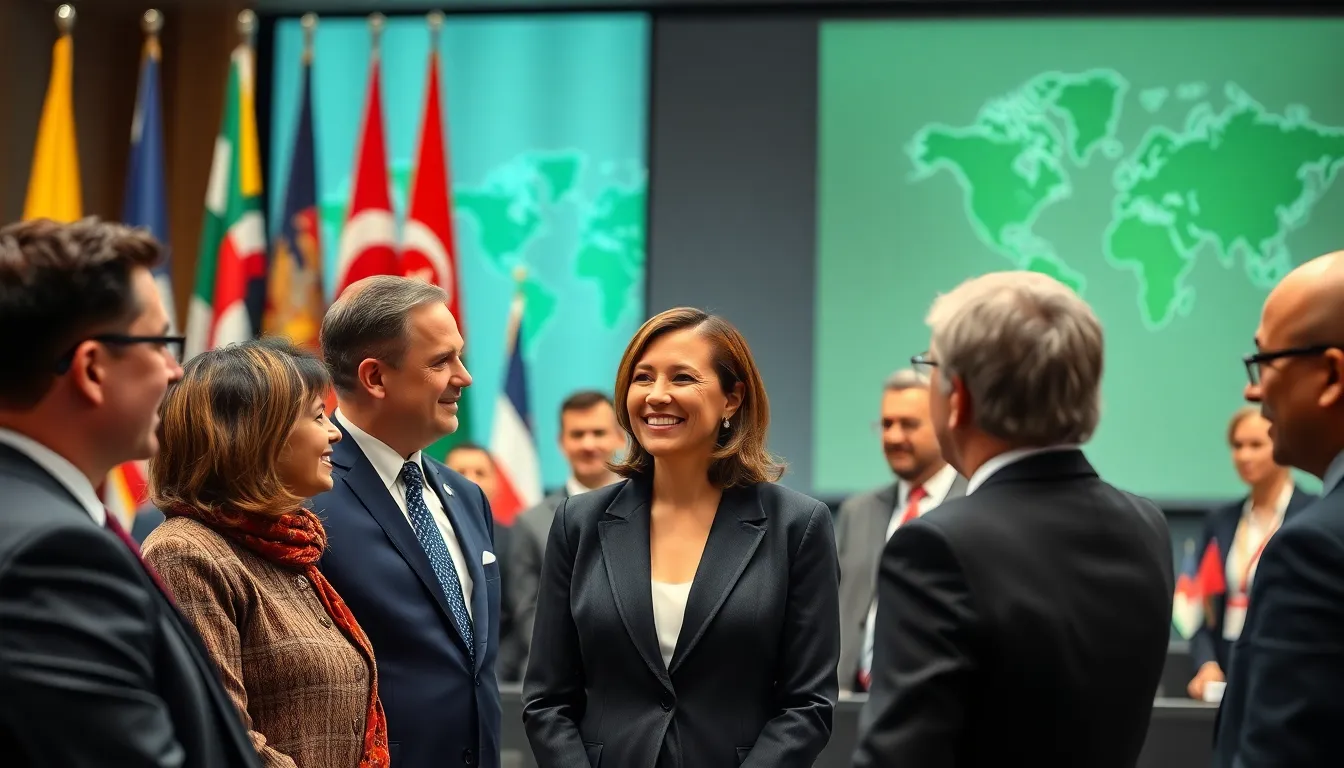In an increasingly interconnected world, international developments shape the landscape of global politics, economics, and culture. From trade agreements to climate change initiatives, these events influence nations and their citizens in profound ways. Understanding these dynamics is crucial for anyone looking to navigate the complexities of today’s global society.
As countries engage with one another through diplomacy and collaboration, the impact of international developments can be seen in everyday life. Whether it’s the rise of new economic powers or shifts in geopolitical alliances, staying informed helps individuals and businesses adapt to the ever-changing global environment. This article delves into key recent developments and their implications, providing insights into how they affect both local and international contexts.
Table of Contents
ToggleOverview of International Developments
International developments encompass a wide range of occurrences that impact global politics, economics, and culture. Recent trends illustrate significant changes in diplomatic relations, trade agreements, and international policies, which collectively shape the current global landscape.
Political Developments
Political developments reflect shifts in power dynamics among nations. The rise of emerging economies, like India and Brazil, has influenced voting patterns in international organizations. For example, Pakistan’s re-engagement with China and the United States marks a critical change in South Asian geopolitics. Consequentially, nations reevaluate alliances based on strategic interests and security needs.
Economic Developments
Economic developments drive growth and change in global markets. For instance, the expansion of digital currencies influences trade practices and financial regulations internationally. Central banks across Europe and Asia adapt to these innovations, reflecting a commitment to financial stability. Additionally, trade agreements, such as the US-Mexico-Canada Agreement (USMCA), reshape economic partnerships and boost bilateral trades, with experts predicting an increase in cross-border exchanges.
Climate Change Initiatives
Climate change initiatives garner attention as nations increasingly recognize the urgency of this global challenge. The Paris Agreement remains a cornerstone, as countries commit to reducing greenhouse gas emissions. Recent conferences, like COP26, further emphasize collaborative efforts toward sustainable practices. Countries investing in renewable energy, such as solar and wind, illustrate proactive measures to combat climate change while aiming for economic growth.
Global Health Developments
Global health developments highlight the importance of international cooperation in addressing health crises. The COVID-19 pandemic showcased disparities in healthcare responsiveness, prompting discussions about vaccine distribution equity. Organizations like the World Health Organization (WHO) advocate for global health initiatives that prioritize accessibility and prevention strategies. This ongoing dialogue shapes health policy and emergency preparedness on a worldwide scale.
Collectively, these international developments illustrate the interconnectivity of nations, emphasizing the need for engagement and cooperation in tackling shared challenges. By understanding these dynamics, individuals and governments can better navigate the complex influences shaping their lives and futures.
Key Trends in Global Politics

International developments continue to influence the landscape of global politics. Key trends include a rise in multilateralism and a shift toward regional alliances.
Rise of Multilateralism
Multilateralism is emerging as a central theme in global governance, characterized by cooperation among three or more states to address shared challenges. Organizations like the United Nations (UN) and World Trade Organization (WTO) facilitate collaborative efforts in areas such as climate change, trade, and security.
Significant events, including the adoption of the Paris Agreement in 2015, demonstrate nations’ commitment to collective action on climate issues. Additionally, forums like the G20 have expanded to represent emerging economies, emphasizing inclusivity in economic discussions.
Countries increasingly recognize that global problems, such as pandemics and resource depletion, can’t be tackled in isolation. Continuous engagement in multilateral discussions fosters stronger alliances and shared responsibilities among nations.
Shift Towards Regional Alliances
Regional alliances are gaining traction as countries prioritize localized cooperation to address specific issues. Agreements, such as the African Continental Free Trade Area (AfCFTA) and the Comprehensive and Progressive Agreement for Trans-Pacific Partnership (CPTPP), reflect this trend, fostering economic integration and collaborative frameworks within regions.
Simultaneously, existing alliances, like the European Union (EU) and the Association of Southeast Asian Nations (ASEAN), continue to strengthen cooperation in trade, security, and cultural exchange. Leaders often prioritize regional partnerships to bolster economic resilience while addressing security concerns related to global uncertainties.
The growth of these regional alliances shows a strategic pivot toward localized collaboration, indicating a transforming geopolitical landscape. Countries seek to enhance their competitiveness and address challenges uniquely affecting their regions.
Economic Impacts of International Developments
International developments directly influence economic landscapes through trade agreements and disputes, along with fluctuations in global supply chains.
Trade Agreements and Disputes
Contemporary trade agreements shape economic resilience and interdependence among nations. Recent agreements, such as the Regional Comprehensive Economic Partnership (RCEP), involve significant economies like China, Japan, and South Korea, enhancing trade flows in the Asia-Pacific region. These agreements often reduce tariffs, foster cooperation, and stimulate market access, benefiting participating countries and their industries.
Disputes can disrupt established trade relationships, affecting pricing and availability of goods. For example, ongoing tensions between the United States and China have led to tariffs on billions of dollars’ worth of goods, impacting both consumer prices and businesses. The World Trade Organization (WTO) plays a crucial role in mediating these disputes, aiming to restore balance and fairness in global trade.
Global Supply Chain Changes
Global supply chains experience significant shifts due to international developments. The COVID-19 pandemic highlighted vulnerabilities in supply chains, prompting companies to reassess sourcing strategies. These adjustments encourage diversification of suppliers and localized production, reducing dependence on a single region.
Additionally, geopolitical tensions fuel supply chain transformations. Nations increasingly prioritize domestic production to secure critical goods, such as semiconductors and medical supplies. This trend leads to increased investment in manufacturing capabilities and infrastructure, fostering economic independence in strategic sectors. Policymakers support these shifts, promoting incentives for local production that aligns with national interests.
Social and Cultural Dimensions
Social and cultural dimensions of international developments reflect shifts in human connections and societal values. These dimensions arise from migration patterns and the influence of technology on communication.
Migration Patterns
Migration patterns reshape demographics and cultural landscapes globally. Numerous individuals migrate for economic opportunities, safety, and education. In 2020, approximately 281 million people, or 3.6% of the world’s population, lived outside their countries of birth, marking a significant increase from previous years.
Countries like the United States, Germany, and Canada welcome diverse groups, leading to increased multiculturalism. Migration also affects labor markets, contributing to economic growth while sometimes straining resources in host countries. Migrants contribute skills and innovation, fostering cultural exchange and integration.
Influence of Technology on Communication
Technology significantly influences communication on an international scale. The widespread availability of the internet and social media platforms facilitates instant connectivity. In 2022, over 4.9 billion people accessed the internet, enabling real-time communication and the sharing of cultural content.
Digital platforms like Twitter, Facebook, and WhatsApp bridge geographical gaps, allowing individuals to connect beyond borders. These technologies contribute to the formation of global communities that foster understanding and reduce cultural divides. Furthermore, advancements in communication technology support the spread of movements advocating for social justice and environmental sustainability on a global scale, uniting individuals in pursuit of common goals.
Environmental Considerations
International developments increasingly prioritize environmental factors, addressing climate change through cooperative agreements and sustainable initiatives. This section examines critical environmental considerations shaping global policies and actions.
Climate Agreements and Policies
Climate agreements play a vital role in fostering international cooperation on environmental issues. The Paris Agreement, adopted in 2015, aims to limit global warming to well below 2 degrees Celsius, with countries committing to nationally determined contributions (NDCs) reflecting their climate action plans. In 2021, the 26th UN Climate Change Conference (COP26) underscored nations’ accountability, resulting in pledges to enhance targets and support climate finance for developing countries.
Key policies, such as carbon pricing and emissions trading systems, incentivize green practices while penalizing excessive carbon emissions. For instance, the European Union’s Emissions Trading System (EU ETS) sets a cap on emissions from power plants and factories, trading allowances to encourage reductions. Such frameworks demonstrate the global commitment to transition toward a low-carbon economy.
Sustainable Development Goals
Sustainable Development Goals (SDGs) provide a comprehensive framework for addressing environmental concerns alongside social and economic dimensions. Adopted in 2015 by the United Nations, the 17 SDGs aim to achieve a better and more sustainable future by 2030. Goals like Affordable and Clean Energy (SDG 7) and Climate Action (SDG 13) focus on promoting environmentally friendly practices and investing in renewable energy sources.
In 2021, the UN reported progress in areas such as clean water (SDG 6) and life below water (SDG 14), yet emphasized the urgent need for enhanced efforts to tackle climate action and reduce inequality tied to environmental degradation. Businesses, governments, and civil societies increasingly align their strategies with SDGs, recognizing that sustainable development is crucial for long-term prosperity and environmental resilience.
International developments are reshaping the world in profound ways. The interconnectedness of nations highlights the necessity for collaboration in addressing pressing issues like trade, climate change, and health. As emerging economies gain influence and regional alliances strengthen, the global landscape continues to evolve.
Understanding these dynamics empowers individuals and governments to navigate challenges effectively. By fostering cooperation and embracing change, societies can work towards a more sustainable and equitable future. The ongoing dialogue among nations will be crucial in forging paths that benefit all, ensuring that progress is inclusive and impactful.



